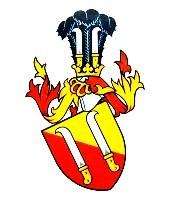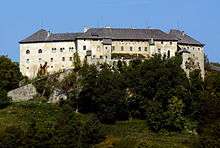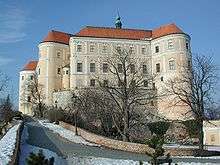Dietrichstein

Dietrichstein was the name of a Bohemian and Austrian noble family originating from Carinthia. The Nikolsburg (Mikulov) branch was elevated to Princes of the Holy Roman Empire in 1624.
History

Dietrichstein Castle near Feldkirchen in the Duchy of Carinthia was first mentioned in a 1103 deed. It was probably named after one knight Dietrich in the service of the Carinthian dukes. In 1166 the Dietrichstein estates were acquired by the Prince-Bishops of Bamberg and enfeoffed to a family of ministeriales officials, who began to call themselves after the castle. When the line became extinct in the early 14th century, the fief was inherited by Nikolaus I, another Carinthian ministerialis from nearby Nussberg Castle, whose descendants also called themselves von Dietrichstein.
In the late 15th century, the strategically important fortress overlooking the trade route along the Glan valley down to Sankt Veit was occupied by the Hungarian forces of King Matthias Corvinus and finally destroyed by Ottoman invaders in 1483. A new castle was erected below the ruins about 1500 and rebuilt in a Neoclassical style in 1840.


In 1514, Siegmund von Dietrichstein (1484–1533) purchased Hollenburg Castle from the Habsburg emperor Maximilian I, who also elevated him to the noble rank of a Freiherr. In 1572 Siegmund's son Adam von Dietrichstein (1527–1590) was vested with the extended estates of Nikolsburg (Mikulov) in Moravia by Emperor Maximilian II. Adam's grandson Maximilian II von Dietrichstein was created Graf (Count) on 18 September 1612 and his uncle, the Olomouc bishop Franz von Dietrichstein (1570–1636), was elevated as Fürst (Prince) von Dietrichstein zu Nikolsburg on 1624.
The Nikolsburg branch also acquired the titles of Princely Count of Tarasp in 1684, Count of Proskau in 1769, and Count Leslie of Balquhain in 1802. The line became extinct upon the death of Prince Moritz of Dietrichstein in 1864. Four years later, Alexander von Mensdorff-Pouilly, former Austrian foreign minister and husband of Moritz' cousin Alexandrine, was vested with the princely title by Emperor Franz Joseph I. The Princes of Mensdorff-Pouilly-Dietrichstein died out in 1964.
Notable members
- Franz Seraph (1570–1636), Prince of Dietrichstein, Bishop of Olomouc, Cardinal and Landeshauptmann of Moravia.[1]
- Maximilian, Prince of Dietrichstein (1596–1655), nephew of the last
- Ferdinand Joseph, Prince of Dietrichstein (1636-1698), son of the last
- Leopold Ignaz Joseph, Prince of Dietrichstein (1660–1708), son of the last
- Walther Franz Xaver Anton, Prince of Dietrichstein (1664–1738), brother of the last
- Karl Maximilian Philipp Franz Xaver, Prince of Dietrichstein (1702–1784), son of the last
- Karl Johann Baptist Walther Sigismund Ernest Nepomuk Alois, Prince of Dietrichstein (1728–1808), son of the last
- Franz Seraph Joseph Carl Johann Nepomuc Quirin, Prince of Dietrichstein (1767–1854), son of the last
- Joseph Franz, Prince of Dietrichstein (1798–1858), son of the last
- Moritz Joseph Johann, Prince of Dietrichstein (1775–1864), son of Prince Karl Johann.
In 1857, Alexandrine, daughter of Prince Joseph Franz, married Count Alexander von Mensdorff-Pouilly. He served as Foreign Minister and briefly Minister-President of Austria in the 1860s, and in 1868 was created Fürst von Dietrichstein zu Nikolsburg, reviving the title held by his wife's family.
- Alexander Constantin, Prince of Dietrichstein (1813–1871)
- Hugo Alfons Eduard Emanuel Joseph Johann Wenzeslaus, Prince of Dietrichstein (1858–1920), son of the last
- Alexander Albert Olivier Anton, Prince of Dietrichstein (1899–1964), son of the last.
The diplomat Count Albert von Mensdorff-Pouilly-Dietrichstein was a younger son of Prince Alexander Constantin.
See also
References
Further reading
- Marek, Miroslav. "dietrich/dietrich6.html". Genealogy.EU.
- Theroff, Paul. "mensdorff". www.angelfire.com/realm/gotha/ (Paul Theroff’s Royal Genealogy Site).
- Marek, Miroslav. "bohemia/mensdorff.html". Genealogy.EU.